Vista for Indians, Not for RaGa or RaGu
12 May 2021 12:16:33
The Congress started a campaign on 6 May against the Central Vista Project (CVP) being developed by the Modi government in Delhi. This was not the first time. Opposition started when it was first announced, then when the foundation stone was laid by Modi, and again during the first wave of Covid-19. The initial negative articles, published mostly by the anti-Modi media, were based on ‘expert’ opinions of urban planners and architects who had lost the contest to design the project.
Let me let me tell you what the CVP is all about. By 2027, the Government of India will have infrastructure in Delhi that will be more modern than any other nation’s capital. The 919-acre area around the 2.9–km Rajpath from Rashtrapati Bhawan to India Gate is being redeveloped. Existing buildings of 42.6 lakh square feet, some of which were built in the 1960s and 1970s, are being demolished. Several new buildings totalling ~1.89 crore square feet will be built; with a maximum height of 128 feet, 10 feet lower than India Gate.
You can see below how the current buildings are of haphazard shapes and sizes (mostly built by Congress governments) and how the new Master Plan is well-synchronised.
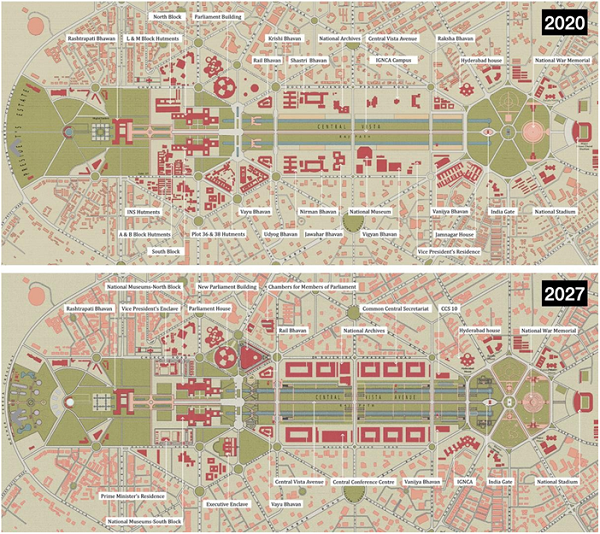
Here are two aerial views, the first one being a close-up, and the second one from a height. In the first image, Rashtrapati Bhawan is on the top (West) and India Gate at the bottom (East). In the second, you can see Connaught Place on the top right. The CVP is budgeted at ₹13,450 crores.
Having been closely associated with the construction of hospitals for six years and real estate projects for 14 years, I estimate that the cost is likely to go up to ₹25,000 crores by the time the project is completed, due to many miscellaneous items not being budgeted and cost escalations. But it is important to keep in mind that this investment (it is not an expenditure) will be spread over seven years, and is not being made only during the Covid-19 pandemic. The only amount being spent from 2020 to Aug 2022 is ₹1,339 crores.
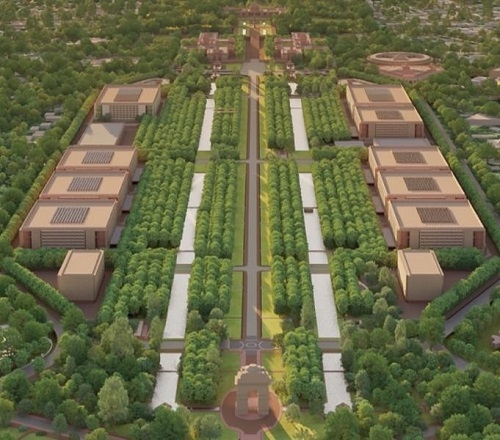
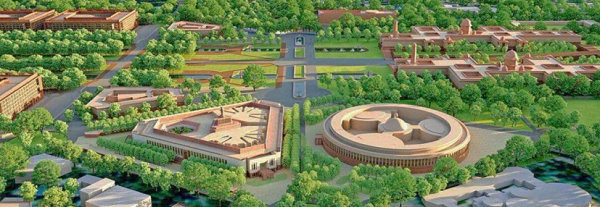
“If British can have 650 parliamentarians, Canada 443 and the US 535 why can’t we have 1000?” asked former President Pranab Mukherjee in Dec 2019. He was not a BJP politician, but spent most of his career in the Congress.
The new Lok Sabha Hall will accommodate 1,224 MPs for a ‘joint’ sitting of both the expanded houses. The existing 93-year-old building has several structural problems and cannot be expanded to accommodate the growth of both houses. It is already crammed. Very few MPs have offices in the current building, and MPs of almost all parties have complained about this several times over the years. Besides, there is no space for staff of MPs. The building is being readied on a war–footing before 15 Aug 2022, to coincide with the 75th anniversary of India’s Independence; hence it cannot be delayed. This was a long overdue need which is being fulfilled.
Features in the Lok Sabha and Rajya Sabha halls will include a desk in every MP’s seat (currently available only in front rows), enough space behind seats for free movement, a touchscreen-based digital voting system, biometric-based dual authentication, and an intuitive multilingual graphical user interface. There will be a Constitution Hall, which visitors can access, to understand India’s journey as a parliamentary democracy. There will also be a lounge and a dining room for MPs, a library, multiple committee rooms, and 1,100 car parks. Each MP will have a 430 square feet office with space for staff.
The new Parliament is being built by TATA Projects at a cost ₹862 crores.
A Central Vista Avenue (see pics), with bridges over canals, pedestrian underpasses, wide footpaths, more green areas than now, benches for seating, and tree-shaded public parking spaces, is being built by Shapoorji Pallonji at an all-inclusive cost of ₹477 crores. The area currently has 4,642 trees—1,412 shall be retained and 3,230 transplanted. This is also being readied on a war-footing to host the 2022 Republic Day parade on 26 Jan. The PM is not the focus on Republic Day—it is the President of India and the Armed Forces, and the Congress party and shameless ‘leftist’ journalists are insulting these two institutions of our democracy by opposing the project, or trying to get it delayed by hook or by crook. They detest any development work of Modi.
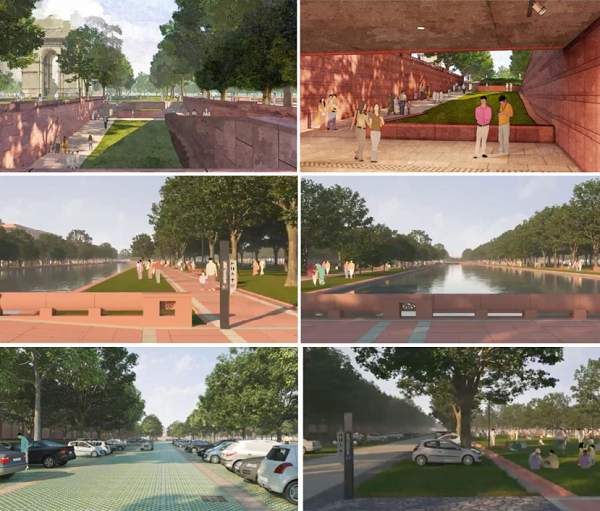
Neither TATA Projects nor Shapoorji Pallonji are Gujarati companies. Both belong to the minority Parsi community, and are amongst the three largest construction companies in India. The CVP includes residential enclaves for the Vice President and the PM, with the Vice President’s residential enclave expected to get completed in end-2022, and the Prime Minister’s residential complex expected to get completed in mid-2023. Modi has been criticised for building a ‘grand new palace’ for himself. ‘Senior’ journalist Alpana Kishore wrote in Newslaundry, “such self-indulgence may be common in dictatorships, but is inappropriate for a Republic. On the other hand, if we are in the Beijing–Moscow– Pyongyang axis where citizens are passive spectators, it is absolutely normal.”
I estimate that the entire PM’s residential complex will cost less than ₹500 crores, including special security measures such as a direct underground tunnel to the new Parliament building. Is this too much for a permanent residence for the chief executive of the world’s second largest country and sixth largest economy? Even if the NDA wins the 2024 general elections and Modi becomes PM again, I’m sure he will give up the post soon after 17 Sep 2025, when he reaches age 75, as he has done for all his ministers. Therefore, at best, Modi will live in the new home for a little over two years.
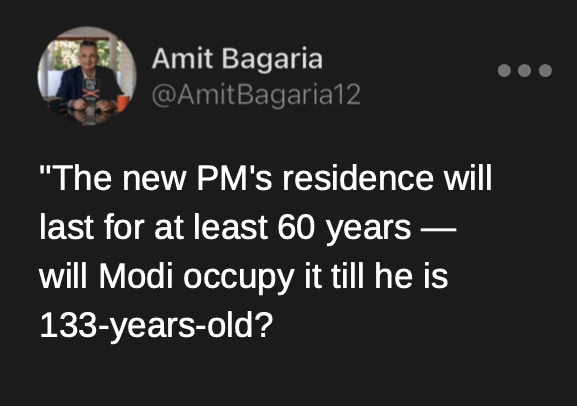
Prime Minister Shastri chose 10 Janpath as his official residence, though Nehru had lived at Teen Murti Bhawan. Indira Gandhi chose 1 Safdarjung Road. Rajiv Gandhi chose 7 Race Course Road (now 7 Lok Kalyan Marg or 7LKM). This was all OK as they were from the Congress? Alpana wrote, “The biggest irony remains that a PM from the humblest of backgrounds should yearn for a house on Rajpath, no less, to endorse his vision of personal greatness and legacy. Would Emmanuel Macron [President of France] demand and, more importantly, get a house on the Champs Elysée? Can even Trump order himself a second home on the Mall?” It is surprising a ‘senior’ journalist like her didn’t do research on the subject—or did she know the truth but chose to hide it? The President of France’s residence is the 1,20,330 square feet “Elysée Palace” located just 500 meters from Champs-Élysées. He also has the use of other homes, including the “Fort de Brégançon” off the French Riviera near Marseille and the “La Lanterne”, a hunting lodge in Versailles, a 35–minute drive from the Élysée Palace. Should Modi get a beach mansion in Goa and a hunting lodge in Uttarakhand?
Now let me come to Trump, who was POTUS (President of the United States) when she wrote the article. POTUS has a second home; it is a 200–acre country retreat called “Camp David”. Even though it’s only 103–km from The White House (the official residence), he mostly flies there on three (and sometimes up to five) helicopters, each costing about ₹1650 crore, the rest serving as decoys. The presidential fleet has 35 helicopters with 23 new ones on order. That’s ₹95,700 crores only for helicopters, four times the cost of the Central Vista project. And the leftist media’s favourite Joe Biden has not cancelled the orders for the 23 new ones to divert the funds for the fight against Covid-19.
The leftist media also call Narendra Modi a fascist, comparing him often with Russian President Putin and Turkish President Erdoğan. In 2014, Erdoğan built himself a 1,000-room 31 lakh square feet palace for US$615 million ($1.3 billion or ₹9,620 crore in 2021 prices based on Turkey’ inflation).
Coming back to the project components, the CVP will have Defence Enclave comprising three buildings, with offices of the Ministry of Defence, the Chief of Defence Staff and the three service chiefs, with special security arrangements. There will be six other buildings to house all the other ministries and departments (apart from defence) of the GOI and their subordinate organisations. All nine buildings have been labelled as the Central Secretariat in the 2027 Master Plan image. The Conference Centre will be the largest government conference facility in the world. There will be total office space for 52,300 people, and parking for almost 10,000 vehicles in basements. There will be no surface parking. An underground Metro will connect the whole Central Vista. There will be underground walkways to connect most buildings.
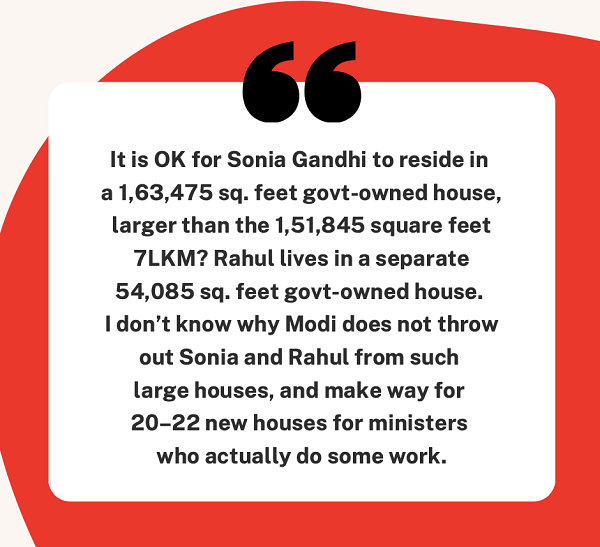
South Block, which houses the PMO, the cabinet secretariat, the defence and foreign ministries and the Office of the NSA, will be converted to a National Museum with the theme ‘India up to 1857’. North Block, which houses the home and finance Ministries, will be converted to a National Museum with the theme ‘India since 1857’. The CVP is expected to greatly improve the GOI’s efficiency due to the synergies of 52,300 people being located within walking distance of each other and standardised modern infrastructure for everybody. Additionally, the GOI spends ₹1000 crore per year as rent and ~₹300 crore on excess security and transport costs due to various ministries and Army/IAF/Navy headquarters not being within walking distance. The investment will be recovered by saving these costs. There will also be some revenue from the museums to be built at the existing North and South Blocks. Add fuel savings, as ~75,000 GOI employees will be at a walking distance with each other, compared to ~41,000 now. And what is the cost vs. benefit of improved efficiency?
The Central Vista zone will be somewhat similar to the area around the “Mall” in Washington, D.C., which includes the White House, the U.S. Capitol (the USA’s ‘parliament house’), the U.S. Supreme Court, several other government buildings, many museums, parks and several monuments. Almost 2.2 crore (22 million) domestic tourists visited the Mall in 2018—with India’s population being 4.2 times that of the USA, imagine the tourism potential of the new Central Vista.
Alpana also wrote about “secrecy and subterfuge” in the selection of the master planner/architect, “with the contract going to a Gujarat architecture firm (HCP) known to be particularly close to the PM, whose previous projects had depended for their execution “upon the removal of ‘obstacles’ like due process, impact assessments, public consultation, and well-established global best practices.” HCP started 41 years before Modi became CM of Gujarat in 2001. they designed the RBI’s Ahmedabad Office in 1971, when there was a Congress CM and Indira Gandhi–appointed S. Jagannathan was RBI governor. In 1985, they designed the Entrepreneurship Development Institute of India, when Rajiv Gandhi was PM. In 1986, HCP designed the refurbishment of the Eden Gardens cricket stadium in Calcutta, where there was a CPI(M) government. In 1992, they designed the Gujarat High Court when Chimanbhai Patel of Janata Dal was CM. In 1994, HCP designed the CG Road redevelopment project in Ahmedabad, when there was another Congress CM. Should I go on?
In April 2020, after Hindustan Times refused to publish a one-sided attack against the CVP (which supported Alpana Kishore’s article) by the so-called historian Ramachandra Guha in his regular weekly columns, he quit from Hindustan Times and got it published in another anti-media website The Wire. He wrote, “I share her concerns entirely. The PM’s own justification is that it was to mark not a personal but a national milestone—the 75th anniversary of Indian independence. This is disingenuous, because past anniversaries had not called for such a spectacular extravaganza. Both the 25th and 50th anniversaries had been suitably marked, by a special session of Parliament. Apparently, what was good enough for Indira Gandhi and IK Gujral wouldn’t quite do for Modi.” Are Parliament sessions suitable celebrations of such important milestones? Who are you kidding? And why does Modi need to copy either Indira Gandhi or Gujral? He’s done many things for the first time for any Indian PM. Guha wrote, “The Modi government’s redesign of Delhi brings to mind not so much living communist autocrats as it does some dead African despots. It is the sort of vanity project, designed to perpetuate the ruler’s immortality, that Felix Houphouet-Boigny of the Ivory Coast and Jean Bédel-Bokassa of the Central African Republic once inflicted on their own countries.”
Brazil built a new capital city (Brasilia) in 1960. Malaysia built Putrajaya in 2001. In Aug 2019, Indonesian President Joko Widodo announced a new capital. South Korea began construction of Sejong City in 2007, with some ministries relocating from Seoul in 2012. Complete relocation of the capital is expected by 2030. Australia built a new Parliament House in 1988. Thailand’s new ₹5,400 crore Parliament House opened this month. Are these countries also like Ivory Coast or Central African Republic?
Let’s come back to India. Chandra Babu Naidu had started building a new capital city (Amravati) for Andhra Pradesh costing over ₹55,000 crores, before he was voted out in 2019. Rajasthan’s new Assembly building was completed in 2001. In 2005, the Congress government in Karnataka built a replica of the old Assembly building in Bengaluru. In 2012, HD Kumaraswamy (a Congress partner) started building a new Assembly building in Belagavi, completed at a cost of almost ₹500 crores in 2012. Why did Karnataka need a second capital? In 2010, Tamil Nadu’s DMK (another Congress partner) started building a new Assembly building for ₹1,200 crores. The foundation stone was laid by Dr. Manmohan Singh and Sonia Gandhi and over ₹3 crores were spent on a temporary dome. After taking over as CM in 2011, Jayalalithaa converted the incomplete building to a hospital-cum-medical college. In 2013, Mamata Banerjee started a ₹350 crore project to revamp the Colonial-era Writers’ Building. In the meantime, she spent ₹50 crores on renovating a temporary office on the Howrah side of the Hooghly river. In 2016, UP CM Akhilesh Yadav (yet another partner of Congress) inaugurated a ₹602 crore new Secretariat building at Lucknow. In 2019, Odisha’s Naveen Patnaik inaugurated a new Secretariat building at Bhubaneswar. Telangana’s KC Rao is building new Assembly and Secretariat buildings for ₹617 crores. All of these are justified, right, because they are all non-BJP governments?
Even during the Covid-19 pandemic, two Congress state governments announced plans for new buildings. In Aug 2020, the Chhattisgarh government announced a 5.65 lakh square feet Assembly building which will cost at least ₹280 crores. In the first week of May 2021, at the height of the second wave, the Shiv Sena–NCP–Congress “Maha Vikas Aghadi” government in Maharashtra floated a tender of ₹900 crores for a MLA hostel of ~10 lakh square feet, and the contractor, the state’s PWD department, says the cost will shoot up further, with the electrical cost alone estimated at ₹250 crores. The tender for ₹9,000 per square feet is already over 1.4 times the cost of constructing a 5-star hotel. And no way can the electrical cost be more than ₹36 crores.
Architect and conservation consultant AG Krishna Menon wrote in The Print on 8 March 2020 that BJP wants to ‘erase’ colonial heritage. Why should we keep ‘colonial’ heritage 75 years after Independence? Is the British Raj something for us to cherish? He also inferred that the CVP does not take care of (ecological) conservation. There is no basis for this. Rather than occupying more space, the Central Vista will free up about 75 acres for public use. A 75-acre National Biodiversity Arboretum has been planned behind Rashtrapati Bhavan, which will have collections of plants from different climatic zones. All buildings will have access to the underground metro with pedestrian subways and will have ample underground parking spaces. This will reduce the carbon footprint from the existing Lutyens Zone of Delhi and will also reduce pollution.
Besides, the overall argument of not enough money being spent on Covid relief is completely baseless. Compared to my estimate of ₹25,000 crores to be spent on the CVP over seven years, the GOI has already sanctioned ₹35,000 crores for Covid-19 vaccination. In addition, the GOI and the RBI put together have already sanctioned over ₹27.45 lakh crores towards other different relief measures, which is more than 108 times the estimated cost of the Central Vista Project.
AAP MLA Mukesh Ahlawat tweeted that the cost of the CVP would have paid for 15 AIIMS hospitals. While the actual number would have been 8–9 AIIMS hospitals, should we not compare with the Congress’s multiple (alleged) scams during Sonia Gandhi’s era (2004–2014)? The ₹10.3 lakh crore Bank NPA scam would have paid for 350 AIIMS, the ₹1.856 lakh crore CoalGate scam 63 AIIMS, the ₹1.76 lakh crore 2G scam 60 AIIMS, the ₹70,000 crore CWG scam 24 AIIMS, the ₹61,250 crore Fake Employees scam 21 AIIMS, amongst many others. All the scams put together in the Sonia-Manmohan era would have paid for a minimum of 540 AIIMS hospitals, almost one for every district in India.

It stated: “The Parliament building was constructed in the 1920s … Over the decades on account of ageing and over use the building has started showing the signs of distress at various places. The present sitting capacity of Lok Sabha and Rajya Sabha is likely to go up after 2026. The seats in Lok Sabha may go up before 2026 also if Women’s Reservation Bill provided for augmented strength is passed by the Parliament. In such a scenario it will be necessary to have a new Lok Sabha chamber with larger sitting capacity.” The letter further stated that instructions should be given to the CPWD (Central Public Works Department) to find an area close to the existing Parliament House complex and to identify a suitable location for constructing a state-of-the-art new Parliament building.
Yet Congress is attacking Modi for doing the exact same thing. This exposes yet another duplicity of the Congress party. The reality is that never again will Central Government offices be overcrowded, dirty and stinky. Never again will government employees waste time in commuting. Corruption will reduce because all public meeting rooms are being put in the front part of every building with glass walls. Is the last point the reason why Congress and AAP are against the project?
..
